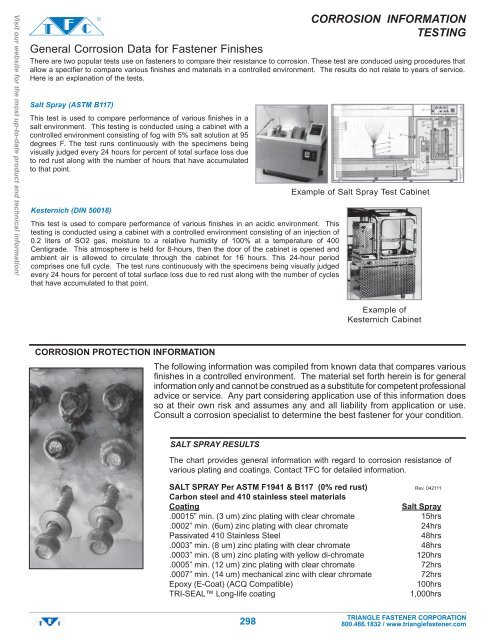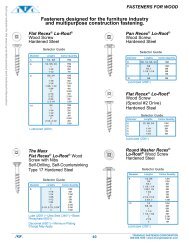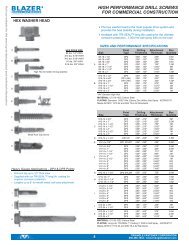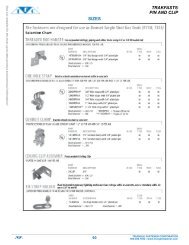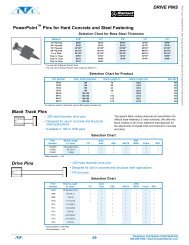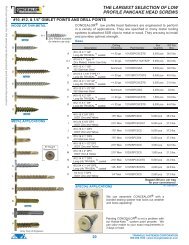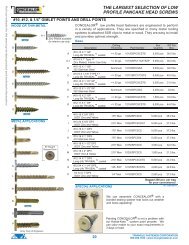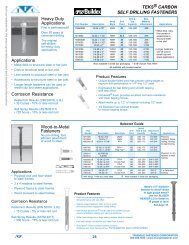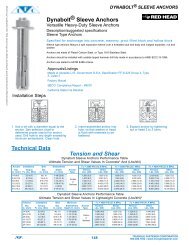Plating - Triangle Fastener
Plating - Triangle Fastener
Plating - Triangle Fastener
Create successful ePaper yourself
Turn your PDF publications into a flip-book with our unique Google optimized e-Paper software.
Visit our website for the most up-to-date product and technical information!<br />
General Corrosion Data for <strong>Fastener</strong> Finishes<br />
There are two popular tests use on fasteners to compare their resistance to corrosion. These test are conduced using procedures that<br />
allow a specifier to compare various finishes and materials in a controlled environment. The results do not relate to years of service.<br />
Here is an explanation of the tests.<br />
Salt Spray (ASTM B117)<br />
This test is used to compare performance of various finishes in a<br />
salt environment. This testing is conducted using a cabinet with a<br />
controlled environment consisting of fog with 5% salt solution at 95<br />
degrees F. The test runs continuously with the specimens being<br />
visually judged every 24 hours for percent of total surface loss due<br />
to red rust along with the number of hours that have accumulated<br />
to that point.<br />
Kesternich (DIN 50018)<br />
This test is used to compare performance of various finishes in an acidic environment. This<br />
testing is conducted using a cabinet with a controlled environment consisting of an injection of<br />
0.2 liters of SO2 gas, moisture to a relative humidity of 100% at a temperature of 400<br />
Centigrade. This atmosphere is held for 8-hours, then the door of the cabinet is opened and<br />
ambient air is allowed to circulate through the cabinet for 16 hours. This 24-hour period<br />
comprises one full cycle. The test runs continuously with the specimens being visually judged<br />
every 24 hours for percent of total surface loss due to red rust along with the number of cycles<br />
that have accumulated to that point.<br />
CORROSION INFORMATION<br />
TESTING<br />
Example of Salt Spray Test Cabinet<br />
Example of<br />
Kesternich Cabinet<br />
CORROSION PROTECTION INFORMATION<br />
The following information was compiled from known data that compares various<br />
finishes in a controlled environment. The material set forth herein is for general<br />
information only and cannot be construed as a substitute for competent professional<br />
advice or service. Any part considering application use of this information does<br />
so at their own risk and assumes any and all liability from application or use.<br />
Consult a corrosion specialist to determine the best fastener for your condition.<br />
SALT SPRAY RESULTS<br />
The chart provides general information with regard to corrosion resistance of<br />
various plating and coatings. Contact TFC for detailed information.<br />
SALT SPRAY Per ASTM F1941 & B117 (0% red rust) Rev. 042111<br />
Carbon steel and 410 stainless steel materials<br />
Coating<br />
Salt Spray<br />
.00015” min. (3 um) zinc plating with clear chromate 15hrs<br />
.0002” min. (6um) zinc plating with clear chromate 24hrs<br />
Passivated 410 Stainless Steel<br />
48hrs<br />
.0003” min. (8 um) zinc plating with clear chromate 48hrs<br />
.0003” min. (8 um) zinc plating with yellow di-chromate 120hrs<br />
.0005” min. (12 um) zinc plating with clear chromate 72hrs<br />
.0007” min. (14 um) mechanical zinc with clear chromate 72hrs<br />
Epoxy (E-Coat) (ACQ Compatible)<br />
100hrs<br />
TRI-SEAL Long-life coating<br />
1,000hrs<br />
298<br />
TRIANGLE FASTENER CORPORATION<br />
800.486.1832 / www.trianglefastener.com
Galvanic Corrosion - compatible metals charts<br />
To minimize galvanic corrosion, fasteners should be considered<br />
based on their material compatibility with the substrates.<br />
Determine the materials being fastened and choose a fastener<br />
material that is close in proximity on the chart. The closer together<br />
the material are on the chart the less galvanic action will occur.<br />
Metals listed on the top of the chart (anotic) will corrode faster<br />
than the metals on the bottom of the chart (cathodic).<br />
Contact a corrosion specialist to determine the best material for<br />
your application.<br />
<strong>Fastener</strong> compatibility for metal roofing and wall cladding<br />
Table developed by the Metal Construction Association Members ( Revised by TFC: 12813JS )<br />
<strong>Fastener</strong> Material<br />
Zinc Plated<br />
Steel<br />
Screws 2<br />
Organic<br />
Coated Steel<br />
Screws 2<br />
Hot-Dip<br />
Galvanized<br />
Steel Nails 3<br />
and Screws<br />
Zinc-Alloy<br />
Head Steel<br />
Screws<br />
Stainless<br />
Capped Head<br />
Steel Screws<br />
Corrosion Information<br />
Galvanic Action<br />
300<br />
Series<br />
Stainless<br />
Steel<br />
400<br />
Series<br />
Stainless<br />
Steel<br />
Metal Roof or<br />
Wall Cladding Material<br />
Aluminum<br />
Copper and<br />
Copper Alloys<br />
Unpainted Galvanized Steel Yes 4 Yes Yes Yes Yes Yes No Yes Yes<br />
Painted Galvanized Steel Yes 4 Yes Yes Yes Yes Yes No Yes Yes<br />
Unpainted Galvalume Steel Yes 4 Yes 4 Yes Yes Yes Yes No Yes Yes<br />
Painted Galvalume Steel Yes 4 Yes 4 Yes Yes Yes Yes No Yes 4 Yes 4<br />
Aluminum No Yes 4 Yes Yes No Yes No Yes No<br />
Copper & Copper Alloys No No No No No No No Yes Yes4<br />
Stainless Steel No No Yes Yes Yes Yes Yes Yes Yes<br />
Zinc alloy No No No Yes No Yes No Yes Yes<br />
Chart was revised by TFC based on various panel manufacturer's specifications and actual job-site performace.<br />
Note 1: Cautionary Guideline: This table serves as a guideline for the selection of fasteners used with metal roofing. The performance<br />
of compatible fasteners shown in this table matches the expected life of the metal roof or wall cladding materials. However, in highly<br />
corrosive environments such as heavy industrial, coastal marine, high airborne pollutants or salt spray, preservative treated lumber or<br />
fire-retardant lumber, the compatibility of certain fasteners with metal roofing or wall cladding materials may be affected. In those types of<br />
applications, the manufacturers of the fastener and metal panel will have specific and unique recommendations.<br />
Visit our website for the most up-to-date product and technical information!<br />
In addition, in the event that certain coating barriers are damaged or scratched through to the substrate there is increased potential for<br />
premature corrosion. Care should be taken during installation and during routine maintenance of the panels in order to protect the integrity<br />
of the coatings used for metal panels.<br />
Note 2: Screws should be plated/coated per ASTM F1941<br />
Note 3: Nails should be galvanized per ASTM A153<br />
Note 4: Not recommended for coastal and heavy industrial environments<br />
Special Note: Preservative-Treated Lumber Applications<br />
ACQ, Penta, CA or CBA preservative-treated lumber can be incompatible with certain types of fasteners. In those cases where any type<br />
of metal roof or wall cladding materials are being attached to preservative treated lumber, the following fasteners are not compatible: zinc<br />
plated screws, zinc-alloy headed screws, stainless capped screws, aluminum, copper and copper alloy. When attaching metal panels to<br />
those types of preservative-treated lumber, a moisture barrier should be used between the lumber and the panel material. Metal panel<br />
fasteners that are compatible with preservative-treated lumber are stainless steel fasteners, or hot dip galvanized nails manufactured<br />
to ASTM A153 class D or heavier. Other types of fasteners coated with proprietary anti-corrosive technologies are also available for use<br />
with preservative-treated lumber. In addition, zinc-plated screws can be used in CCA and MCQ pressure-treated lumber.<br />
299<br />
TRIANGLE FASTENER CORPORATION<br />
800.486.1832 / www.trianglefastener.com
Visit our website for the most up-to-date product and technical information!<br />
Characteristics of <strong>Plating</strong>s, Coatings and Finishes<br />
<strong>Plating</strong>, Coating For Use On Degree of<br />
or Finish Corrosion Resistance Characteristics<br />
Rust inhibitors All metals Varies with type Oils, greases, etc. Vary in color and film thickness. Usually applied to black oxide finishes.<br />
Used to protect parts in transit and temporary storage.<br />
Zinc, electroplated All metals Very good Blue to blue-white gray color.<br />
Cadmium, electroplated Most metals Excellent Bright silver-gray, dull gray, or black finish. Particularly effective corrosion<br />
protection in marine applications. Used for decorative purposes. High lubricity.<br />
Clear chromate finish Zinc and cadmium Very good to excellent Clear bright or iridescent chemical conversion coating applied to plated parts to enhance<br />
plated parts<br />
corrosion protection, coloring, and paint bonding.<br />
Dichromate Zinc and cadmium Very good to excellent Yellow, brown, green or iridescent colored coating same as clear chromate.<br />
plated parts<br />
Color chromate finish Zinc and cadmium Very good to excellent Olive drab, blue, gold, bronze, etc. Same as clear chromate.<br />
plated parts<br />
Corrosion Information<br />
PLATINGS & APPLICATIONS<br />
Zinc or Manganese Steel Good Black in color. Added protection when oiled with a non-drying petroleum oil containing<br />
Phosphate<br />
corrosion inhibitors. Good lubricity.<br />
Color phosphate coatings Steel Superior to regular phosphate Chemically produced color coating. Available in blue, green, red, purple, etc.<br />
and oiled surfaces<br />
Hot-dip zinc All metals Very good Gives maximum corrosion protection. Dull grayish color Necessitates thread size<br />
adjustments to permit assembly.<br />
Hot-dip aluminum Steel Very good Gives maximum corrosion protection. Dull grayish color. Necessitates thread size<br />
adjustments to permit assemblably.<br />
Mechanically deposited Zinc Steel Very good Dull gray, smooth finish. Corrosion protection depends on coating thickness.<br />
Good coverage in recesses and thread roots.<br />
Tin, electroplated All metals Silver-gray color. Excellent corrosion protection for parts in contact with food.<br />
Hot-dip tin All metals Excellent Same as electroplated but thickness is harder to control.<br />
Lead-tin Steel, usually Fair to good Silver-gray, dull coating. Applied by hot-dip method. Helps lubricity.<br />
Silver, electroplated All metals Excellent Decorative, expensive, excellent electrical conductor.<br />
Chromium, electroplated Most metals Good (improves with copper Bright, blue-white, lustrous finish. Has relatively hard surface.<br />
and nickel undercoats)<br />
Used for decorative purposes or to add wear resistance.<br />
Copper, electroplated Most metals Fair Used for nickel and chromium plate undercoat. Can be blackened and relieved to obtain<br />
Antique, Statuary, and Venetian finishes.<br />
Brass, electroplated, lacquered Steel, usually Fair Brass electroplated which is then lacquered.<br />
Recommended only for indoor decorative use.<br />
Bronze, electroplated, lacquered Steel, usually Fair Has color similar to 80% copper, 20% zinc alloy. Electroplated and then lacquered.<br />
Recommended only for indoor decorative use.<br />
Copper, brass, bronze, Most metals Indoor, very good Decorative finishes. Applied to copper, brass,and bronze plated parts to match colors.<br />
miscellaneous finishes<br />
Color and tone vary from black to almost the original color. Finish names are: Antique,<br />
Black Oxide, Statuary ,Old English, Venetian, Copper Oxidized.<br />
Bright nickel Most metals Indoor excellent. Outdoor good Electroplated silver-colored finish. Used for appliances, hardware, etc.<br />
if thickness at least 0.0005 in.<br />
Dull nickel Most metals Same as bright nickel Whitish cast. Can be obtained by mechanical surface finishing or a special satin bath.<br />
Lacquering, clear or All metals Improves corrosion resistance. Used for decorative finishes. Clear or colored to<br />
color-matched Some types designed for humid match mating color or luster<br />
or other severe applications<br />
Anodizing Aluminum Excellent Acid electrolytic treatment. Frosty-etched appearance.<br />
Hard oxide surface gives excellent protection.<br />
Passivating Stainless steel Excellent Chemical treatment. Removes iron particles and produces a passive surface.<br />
300<br />
TRIANGLE FASTENER CORPORATION<br />
800.486.1832 / www.trianglefastener.com


